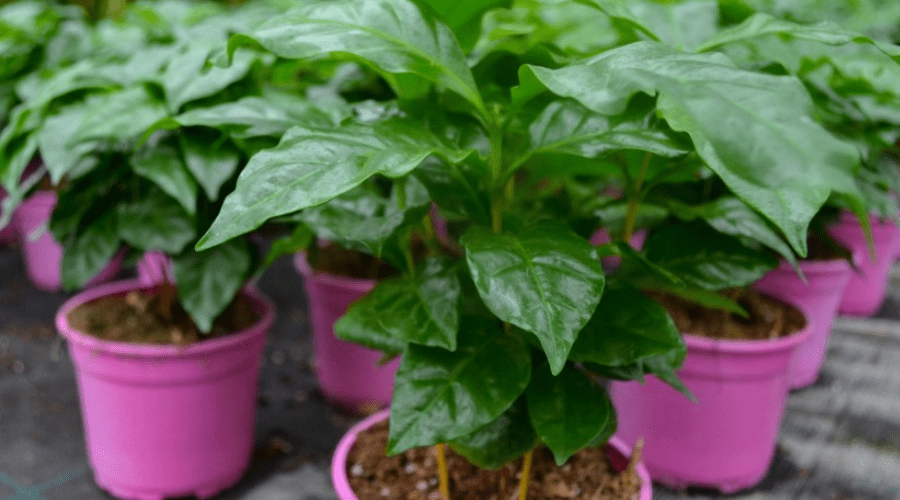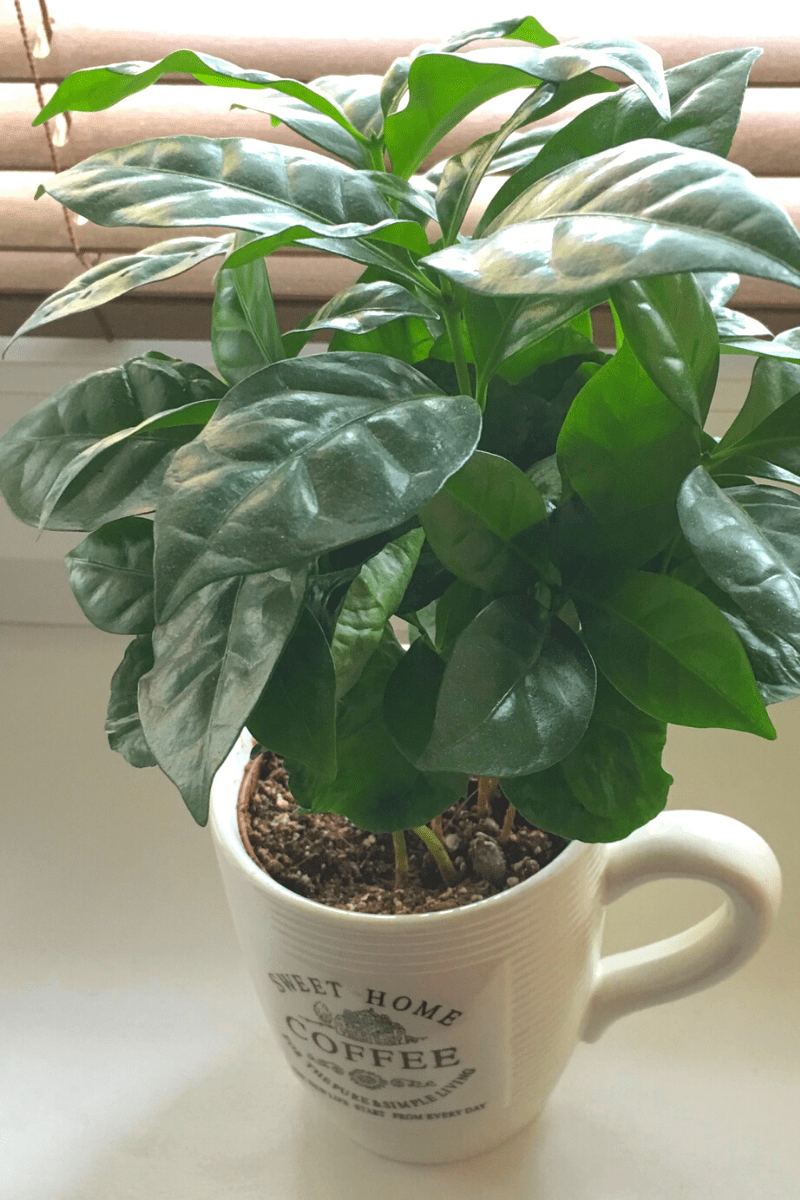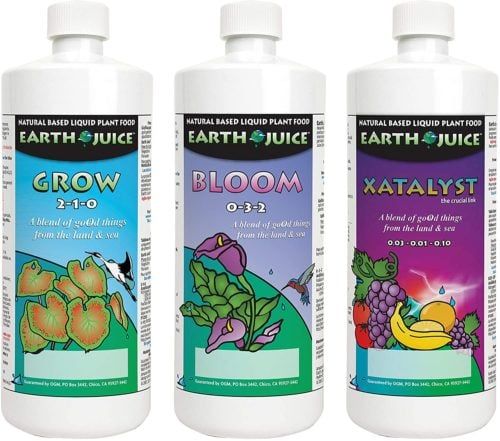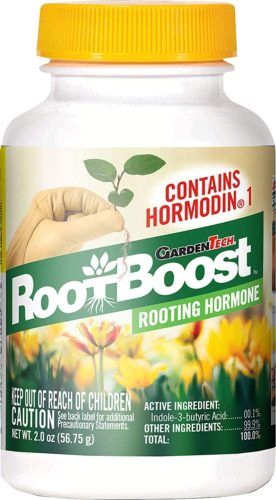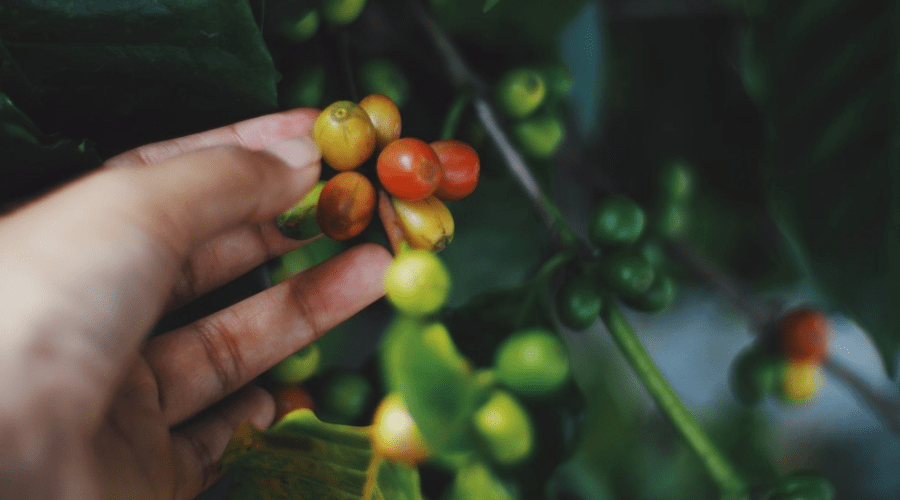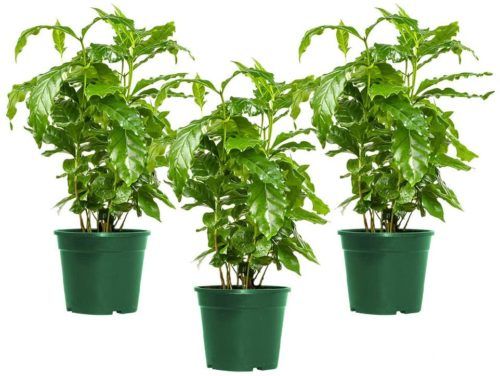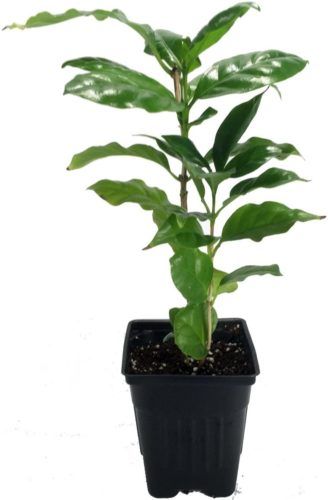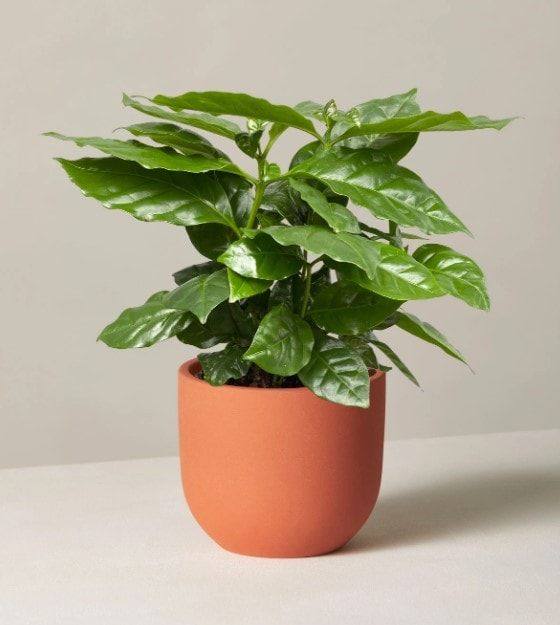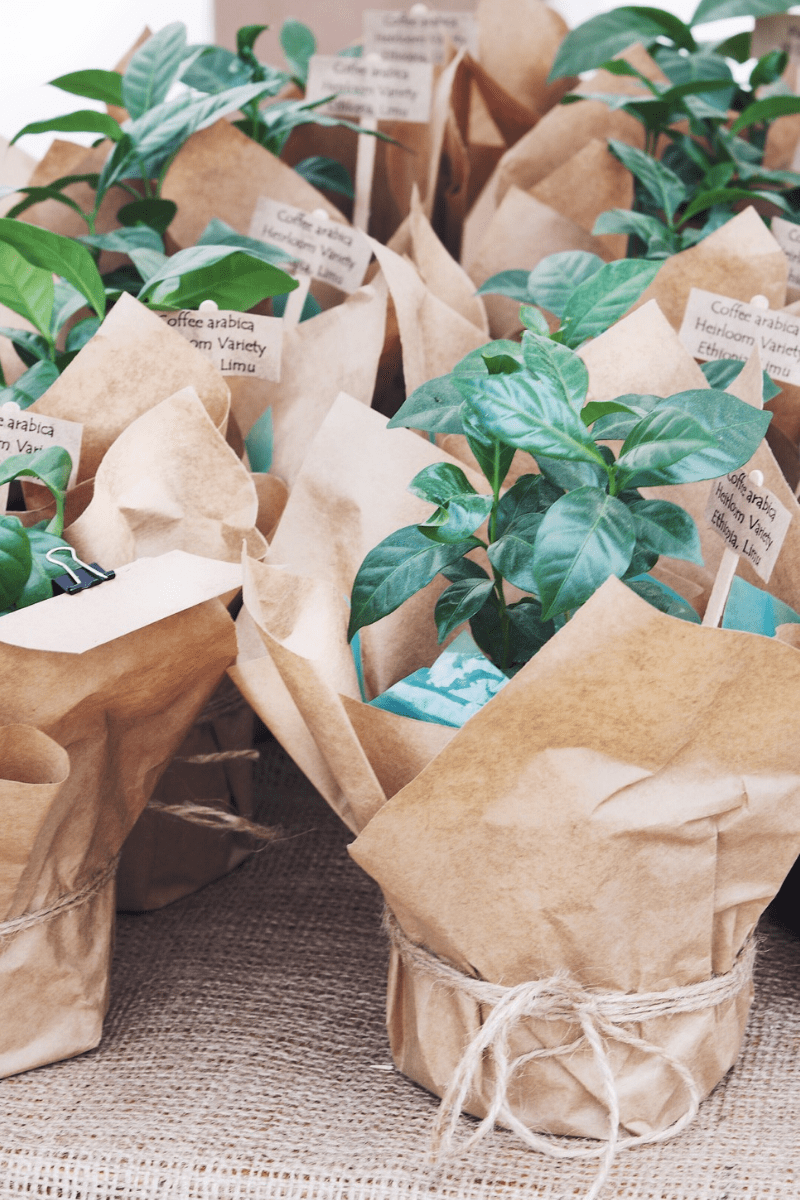You know you love coffee. You know you love house plants. So of course, you would love a coffee house plant. Coffee plants are easy to care for, have beautiful, dark-green, glossy leaves, and after a couple of years even produce coffee beans. This complete guide explains everything you need to know about how to care for a coffee plant, with in-depth care instructions and helpful coffee plant growing information.
Coffee Plant Details
Coffea arabica
AKA Coffee Plant
Light: Bright, indirect light
Water: Regular waterings
Temperature: 65 - 70 F
Size: 6 - 15 Feet Tall and Wide
Pests: Mealybugs, aphids, mites
Disease: Root rot
Toxicity: Toxic to humans and pets
Coffee Plant Benefits
Coffee and house plants have a lot in common. For starters, they both make you feel happier. Merely smelling a cup of coffee can make you smile, and just being around plants boosts your mood.
Coffee is known for increasing alertness, but did you know plants do too? Being near plants allows people to focus more, enabling brain functions like memory. A study by The Royal College of Agriculture in Cirencester, England found that students who were in a room with plants were 70% more focused than students who were not.
Between enhancing alertness and positively affecting moods, it’s clear that coffee and house plants are two great things to have in your life. The blend of both of them in a coffee plant makes it a must-have addition to your windowsill garden.
Coffee Plant Care
Coffee plants are very easy to care for as long as you keep in mind that they are tropical plants so they require tropical conditions to flourish. Don’t panic, you can very easily turn your studio apartment’s crowded windowsill into the tropics. All you need to do is feed your plant lots of water, regularly mist it with humidity, and provide it with indirect, dappled light. Your plant won’t even know the difference.
Light
Place your coffee plant in a spot with bright, indirect light. Try a window with shade or blinds, or a spot a few feet away from a window that gets direct light. If your plant is exposed to too much light its leaves will turn brown.
Temperature & Humidity
The best temperature range for coffee plants is between 65 - 70 F degrees. It’s true that hotter temperatures can make your plant grow faster, but in exposing your plant to higher heat you limit its chances of producing beans.
The humidity around your plant should be about 50%. You can provide it with humidity by misting it daily, growing it in your bathroom so it can benefit from shower steam, or through using a humidity tray. If your plant doesn’t get enough humidity its leaves’ edges will start to turn brown.
Water
Water your plant at least once a week, striving to keep the soil evenly moist. Coffee plants love water, so unlike many other house plants, you should not allow their soil to dry out. Of course, avoid leaving standing water on your plant’s soil or it could develop root rot.
Container & Soil
With all the watering you have to do, you need a soil and container that are built to enable drainage. Peat-based potting soil is an excellent option for cactus plants, along with other well-draining potting mixes. Coffee plants grow best in soil that is slightly acidic.
Fertilizer
It’s not necessary to feed your coffee plant fertilizer, however, if you really want it to flourish, you should. Supply it with a dose of diluted liquid fertilizer every couple of weeks during the growing season in the spring and summer. You do not have to fertilize in the fall and winter.
Earth Juice Starter Kit
Earth Juice Grow is a natural based liquid fertilizer that is formulated to encourage vigorous vegetative stem and leaf growth for all indoor and outdoor plants. Earth Juice Bloom is also a natural based liquid plant food. It encourages rich development of flowers, fruit and vegetables, as well as aids in the creation of essential oils, resins and fragrances of flowering and fruiting plants. Lastly, Earth Juice Xatalyst is a molasses-kelp based product that encourages opulent fruit, increased sugar and superior result on flowers and fruit. Xatalyst should be used in conjunction with the Grow and Bloom products to increase overall flowering and flavor.
Repotting
Every spring, repot your coffee plant in a container that is one size bigger. Be very gentle with the plant’s roots when transplanting it. If you are trying to keep your plant’s growth under control, you can restrict its pot size along with pruning it.
Coffee Plant Pruning
The growth rate of your cravings for coffee is only matched by how quickly coffee plants can grow. Coffee plants, even those grown indoors, can grow to be 10 feet tall. If you don’t have enough space in your home for a 10-foot plant, then consider pruning yours.
Prune in early spring with sharp, clean pruners. Coffee plants are resilient and fast growers so don’t be afraid to hack off a lot of the plant. You can prune your coffee plant by cutting it way back, removing dead and dying branches and foliage, or by just pinching new growth. Pinching new growth encourages your coffee plant to grow in a bushier shape and can make the plant healthier as a whole. Make cuts at a 45-degree angle just above where the leaf attaches to the plant’s stem. You can cut young stems to use in propagation.
Coffee Plant Propagation
I know what you’re thinking because the thrifty part of me was wondering the same thing: can coffee beans you buy at the store sprout a coffee plant? The answer is, unfortunately, no. Because those beans have been treated and roasted they cannot create coffee plants. You have to procure coffee seeds directly from a plant to propagate them. You can also propagate coffee plants from cuttings.
Take cuttings in the early summer, snipping off straight shoots that are at least 8 inches long. When transporting the cutting wrap it in a damp paper towel. Remove all of the leaves on the bottom only allowing a few on the top of the cutting to stay. Plant the cutting, cut-side down into a small pot full of potting mix that is composed of half perlite and half peat moss. You can dip the cutting in rooting hormone before planting it to increase the odds of it growing roots.
RootBoost Rooting Hormone Powder (2 Pack)
This product is made for rooting house, foliage, tropical, and hardy ornamental plants, as well as leaf, greenwood, and softwood cuttings. Simply take plant cuttings, usually 4 to 6-inch stem cuttings, from the current year’s growth and dip stem cutting into powder. Plant immediately in moist media. Two 2-ounce jars.
Place a plastic bag over the cutting and put it in a warm location with indirect light. Make sure to keep the growing environment in the bag moist and humid. Keep the mix moist. After a few weeks, check to see if there is resistance when you pull the cutting up. If there is, it has formed roots. If not, it needs more time.
When your cutting grows roots, you can repot it and enjoy your new plant.
Coffee Plant Varieties
There are two main varieties of coffee you can grow: coffea arabica and robusta coffee. Coffea arabica makes up more than half of the world’s coffee supply worldwide while robusta coffee makes up a little less but is notable for its intense flavor.
Coffea Arabica
Coffea arabica is the best variety for growing coffee at home, being a low-maintenance, compact plant that produces reliably delicious beans. It has beautiful glossy leaves and includes types that can grow anywhere from a few feet tall to 7 feet tall.
Some standout coffea arabica types include “Nana,” which is the best coffee plant dwarf variety; “Typica,” which has a resilient structure and produces beans with a sweet flavor; and “Gesha,” which sprouts beans with a faintly fruity flavor.
Robusta Coffee
This coffee variety hails from sub-Saharan Africa. The plants are resilient and durable, with the ability to withstand a wide range of environmental conditions. They are far more pest and disease-resistant than coffees arabica plants. Robusta plants are, well, robust. Their strength also extends to their flavor. Robusta plants produce beans that are much stronger, with twice the caffeine content and more of a bitter taste than coffea arabica plants.
Where to Buy Coffee Plants
You can purchase a coffee plant at your local garden center or online. These house plants are hot, hot, hot right now so you should have no trouble finding a vendor that sells them. These are available from Amazon:
American Plant Exchange Arabica Coffee, Three Live Plants
Arabica is one of the worlds finest quality coffee plants. It features glabrous, Glossy, elliptical, dark green leaves with prominent veins and wavy margins, with fragrant (resembles the aroma of Jasmine), star-shaped, White flowers that bloom in axillary clusters. Listing is for three plants in 4-inch growers pots.
Hirt's Arabica Coffee Bean Plant
The first coffee plant of economic importance was Coffea Arabica. It grows to the height of 2-3 feet but the cultivated plants are cut to the height of 1-2 feet to get more width. The leaves of the coffee are lustrous dark green with lighter underside. The flowers emerge from the branches together with the leaves. The white coffee flower has five petals and a scent resembling that of jasmine.
An excellent online option is The Sill’s Coffee Plant. This gorgeous plant has beautiful dark green, shiny petals and is carefully shipped in an elegant terracotta pot. It’s perfect for windowsills arriving in peak condition in a compact size.
Coffee Plant
You might be surprised to know the same plant that grows your morning coffee beans is a popular, low maintenance houseplant! Although it’s unlikely this plant will produce berries inside, its attractive shiny green foliage will liven up any interior space. It comes with our Grant terracotta planter, ready to enjoy and watch grow.
Coffee Plant Common Questions
Do you still have coffee plant care concerns? Don’t let them brew in your mind, check out the section below that answers all of the most common coffee plant growing questions.
Can You Harvest Coffee Plants?
Yes, you can harvest coffee plants if your plant sprouts berries, however, in indoor growing conditions it’s unlikely that your plant will. In fact, even if your plant was capable of growing coffee beans you would still have to wait a few years to see them, and it's unlikely there would even be enough to brew one cup of coffee.
When grown in ideal conditions coffee plants first flower, then produce berries that contain the coffee beans inside. To make sure this process happens, use all of the care tips in this guide and also regularly hand pollinate your plant during the growing season.
What is the Growth Rate of Coffee Plants?
Coffee plants are quick growers. When grown outdoors can reach as tall as 15 feet. Indoors they tend to stay more in the 6-foot range, but that is nothing to sneeze at. That’s why keeping your coffee plant pruned is important. If you don’t prune your plant, it may quickly outgrow the room it's in.
What are Common Coffee Plant Pests and Diseases?
Coffee plants are most frequently targeted by mealybugs, aphids, and mites. If your plant starts to become inexplicably sick and has symptoms like tiny webs, visible insects, or cotton-like balls on it, you may have a pest problem.
First, try to remove the insects using a cotton swab and alcohol. If that doesn’t work try using insecticide or miticide, depending on what your pest problem is. You should act quickly, to protect the rest of the plant, and any plants nearby from suffering the same fate as the fallen foliage.
Coffee plants, like all house plants, can be susceptible to root rot if you overwater them. To prevent root rot never allow standing water to just sit on your plant’s soil. To prevent other infections, make sure there is proper air circulation around your plant and that you keep it well-fed and healthy.
Are Coffee Plants Toxic?
Although we love ingesting coffee beans, humans should not ingest any other part of the coffee plant. Coffee plants are also toxic to animals, poisoning cats, dogs, and birds to name a few. If a human or animal is poisoned they will exhibit symptoms like vomiting, loss of appetite, and nausea.
Conclusion
Coffee plants make incredible house plants, being reliably hardy, beautiful to look at, requiring little care, and eventually producing delicious coffee beans. These plants are excellent for beginner or advanced gardeners looking for a gorgeous and helpful addition to their garden.
Fun tip! Coffee plants aren’t the only way to jazz up your garden: coffee grounds can also be used to enrich your soil.
I hope you enjoyed this guide! If you did, be sure to share it and comment below with any questions!

